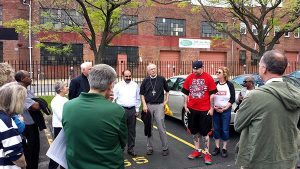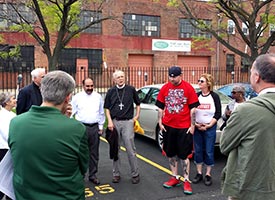By Paula Schlueter Ross (paula.ross@lcms.org)
Seven LCMS pastors — all wearing their clergy collars — joined 10 fellow members of the Synod’s Southeastern District and some 5,000 Baltimore residents and others at a rally and march for peace in that city May 2.

“People were so anxious to talk and to pray — there was a lot of engagement,” Southeastern District (SED) President Rev. John Denninger told Reporter.
Even his group — who had responded to a district call just the day before to join the public march supporting black Americans — wanted to talk.
Afterward, as they met at Martini Lutheran Church in Baltimore “to talk out loud about what we experienced and what sort of things were on everybody’s minds,” Denninger said, he asked them each to give a brief synopsis. But “they couldn’t do it. We were there for 45 minutes, with a lot of impressions of things that they had seen, conversations that they had had, kind of interpreting ‘this is what’s going on’ from different points of view.”
That discussion, he added, really underscored “the importance of the people of the church, wherever we are, to be engaging people where we live because they really have a lot that they want to tell us, I think.
“It’s kind of like an open door. We have a chance to share the Gospel — right in the middle of the pain.”
The idea to join the march was raised as a way to “do something now” during a May 1 meeting of some 25 SED church workers and laypeople who had come together to “provide a time of caring and listening for those who are giving care” and to pray together and determine how to respond to the violence in Baltimore, according to Denninger.
During a pre-meeting tour of Baltimore neighborhoods that had been looted and burned — with the charred remains of buildings and blackened metal of burned-out vehicles still evident — the group saw “very old plywood” as well as the new plywood used to board up windows and doors.
The old plywood, noted Denninger, is an unsettling reminder of damages from civil disturbances that took place decades ago and were never repaired.
“While Freddie Gray is the flashpoint,” he said, the current unrest can be traced to the never-ending hardships of lost jobs and low incomes: “People living for decades in a larger city that has those kinds of [stressful] conditions.”
The Rev. Quentin Poulson, pastor of Calvary Lutheran Church in Baltimore and former director of Urban, Inner-City and Multi-Ethnic Ministries with the LCMS Office of National Mission, shared his insights about “what African-American voices were saying about injustices that were really due to a variety of factors” such as poverty, joblessness and the “unfair treatment” of black males by some in authority, according to Denninger.
Some white pastors at the district meeting lamented that they, themselves, have not spoken out against racial comments within their own churches.
One white pastor — talking about his neighbor who had made racial slurs — regretted that he’d been silent in the face of such prejudice. “Even our silence — we need to ask forgiveness for that,” Denninger recalled the pastor saying.
Participants at the SED meeting appreciated the opportunity to share their feelings and experiences, the district president acknowledged.
“Unless we have time to download it and talk out loud about it, we end up internalizing that [pain] and probably missing a moment of actually opening ourselves up to our own healing,” he said.
Baltimore — and “how God is calling us to be His presence in this time in the city” — was the topic of an SED webinar hosted by Denninger May 5.
The Rev. Steven D. Schave, director of LCMS Urban & Inner-City Mission and LCMS Church Planting, visited representatives of LINC Baltimore May 13 “to assess the situation and to minister to people who were affected” by the earlier unrest. (To watch a video interview between Schave and the Rev. Martin Schultheis, pastor of Emmanuel Lutheran Church in Baltimore, visit the LCMS City Mission Facebook page.)
Schave said the Synod also plans to host a conference this fall that’s designed to “help us understand our place as church in these disenfranchised communities.” Reporter will share more information about the conference as it becomes available.
Although the city remained peaceful at this writing — six Baltimore police officers have been charged with a range of crimes including murder and manslaughter in the arrest and fatal injury of Freddie Gray — SED leaders continue to call for prayers for peace not only for Baltimore but for cities nationwide that are experiencing racial tensions.
Prayers are “absolutely” still needed, says Denninger, “because the concern right now is what might happen next.”
Posted May 5, 2015 / Updated May 6, 2015, and May 22, 2015
